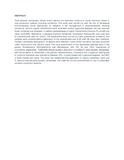Evaluation of selected methods in the control of plant parasitic nematodes infecting carnation.

Date
2014Author
Kimenju, J.W
Wachira, PM
Lang'at, J K
Otineo, W
Mutua, G K
Type
ArticleLanguage
enMetadata
Show full item recordAbstract
Plant parasitic nematodes, whose control options are restricted, continue to cause enormous losses in crop production systems including carnations. This study was carried out with the aim of developing environmentally sound approaches for adoption in the management of phytonematodes affecting carnations. Various organic amendments were evaluated namely sugarcane bagasse, tea and assorted flower composts and molasses, in addition nematophagous fungus Paecilomyces lilacinus (PL plus®) and neem (Achook®). Meanwhile, a standard chemical nematicide, fenamiphos (Nemacur®), was used next to untreated plots were as control. The experiments were carried out under greenhouse conditions. Soil samples were collected before application of the amendments and at 90 and 180 days after treatment. Parasitic nematodes belonging to 16 genera were detected in plots where carnation had been produced under monoculture over several years. The most predominant of the nematodes detected were in the genera Scutellonema, Helicotylenchus and Meloidogyne, with 100, 82 and 100% frequencies of occurrence, respectively. Treatments effects caused a reduction in numbers of plant parasitic nematodes, with the exception of nematodes in the genera Helicotylenchus, Criconema and Longidorus. Galling due to root-knot nematode was reduced by between 53%, in plots treated with sugarcane bagasse, and 69% in those treated with neem. This study has established that application of organic substrates, neem and P. lilacinus reduced plant parasitic nematodes. The materials can be recommended for use in sustainable carnation production systems.
URI
http://www.cabdirect.org/abstracts/20143112050.html?resultNumber=0&q=kimenju+j+2014http://www.cabdirect.org/abstracts/20143112050.html?resultNumber=0&q=kimenju+j+2014
http://hdl.handle.net/11295/66010
Citation
Journal of Agricultural Science (Toronto) 2014 Vol. 6 No. 3 pp. 31-38Publisher
University of Nairobi,
